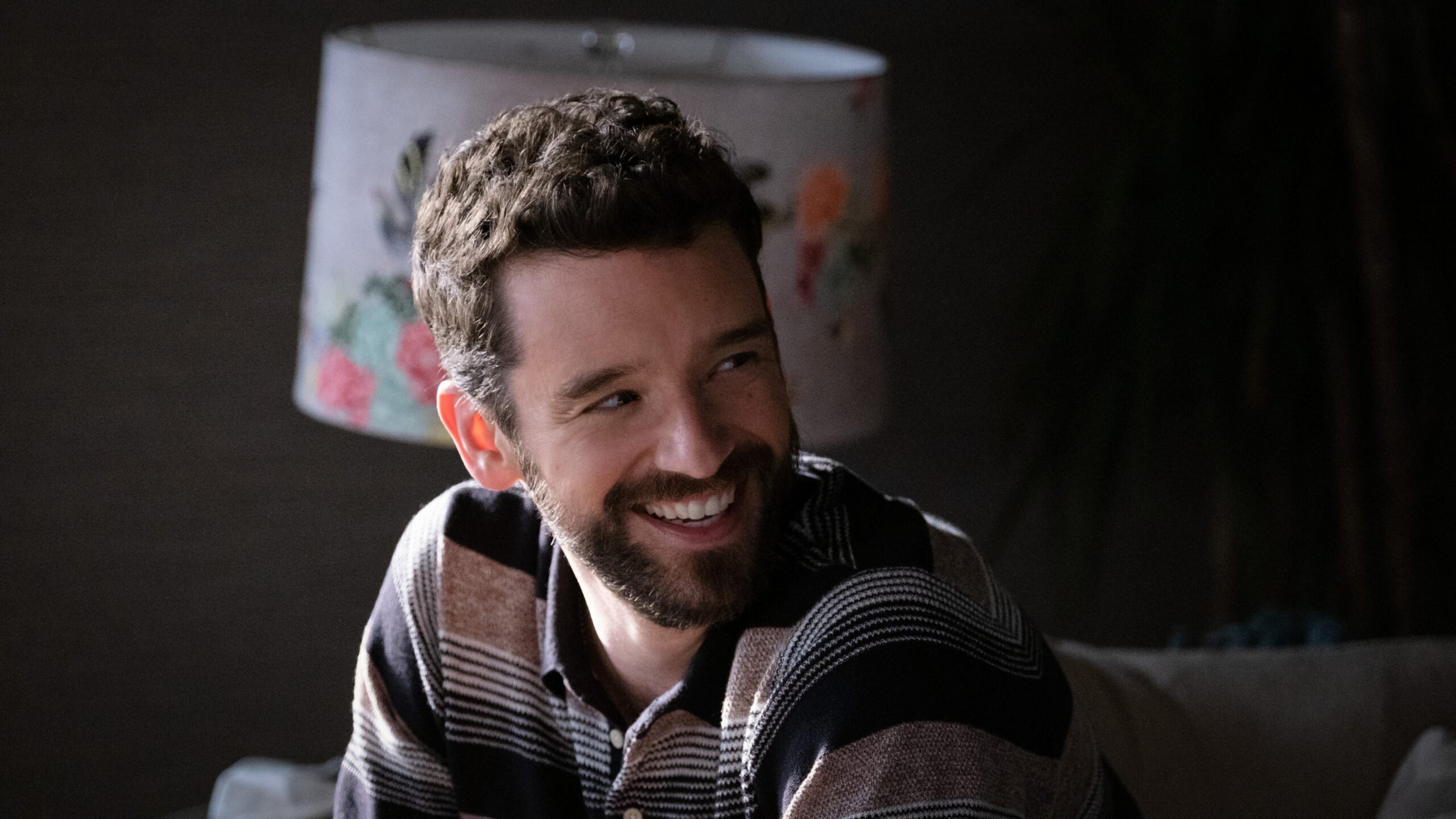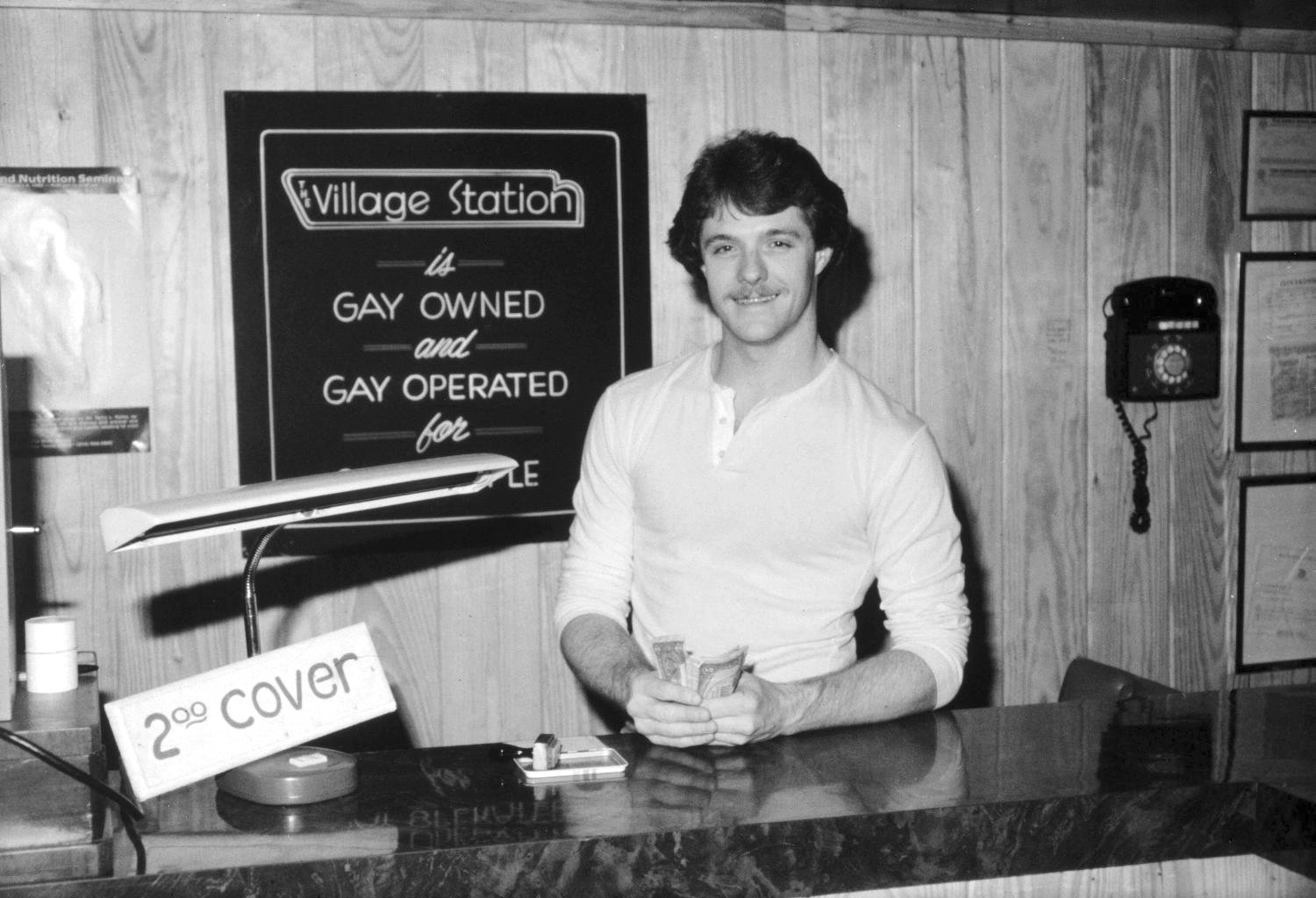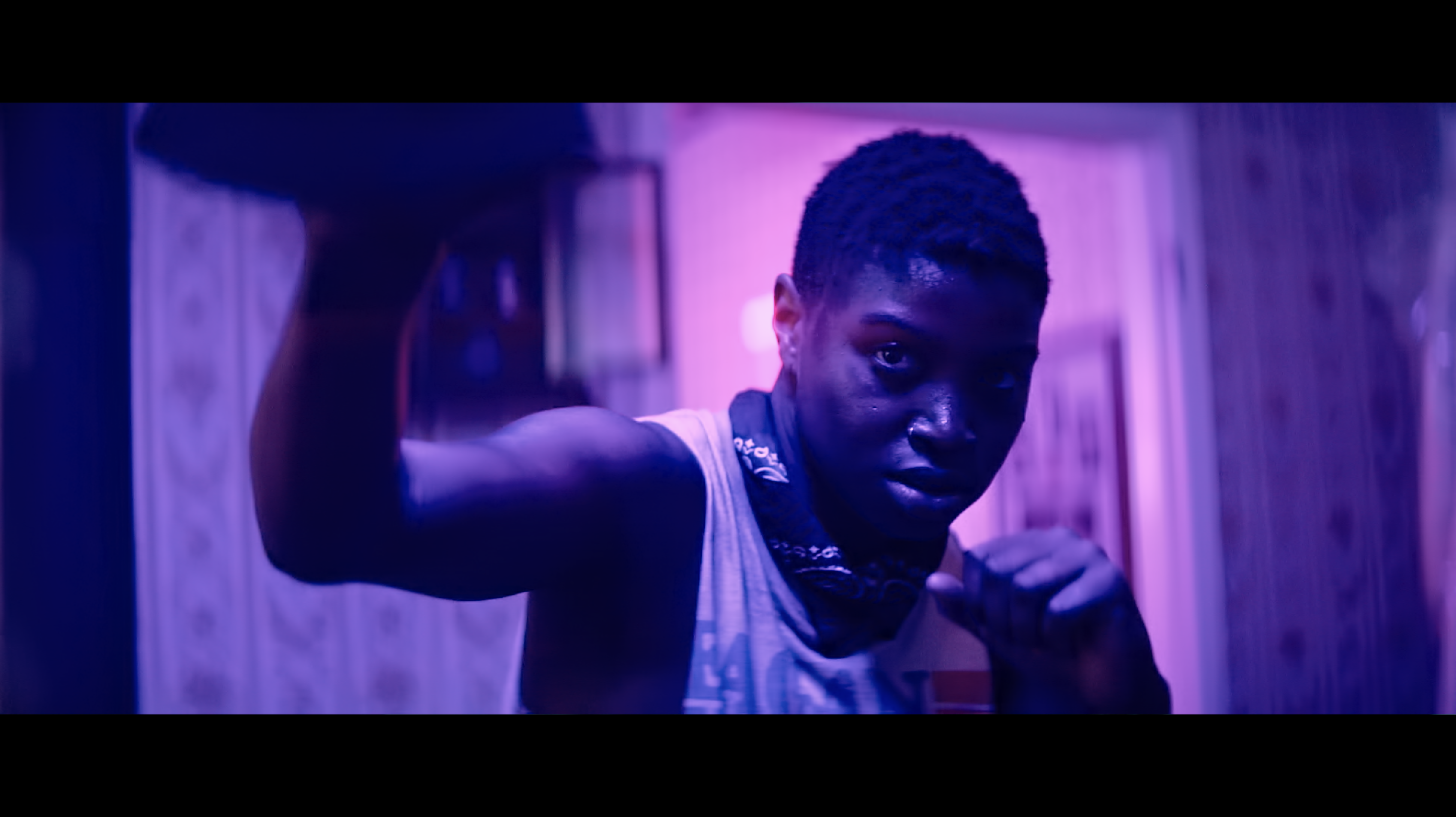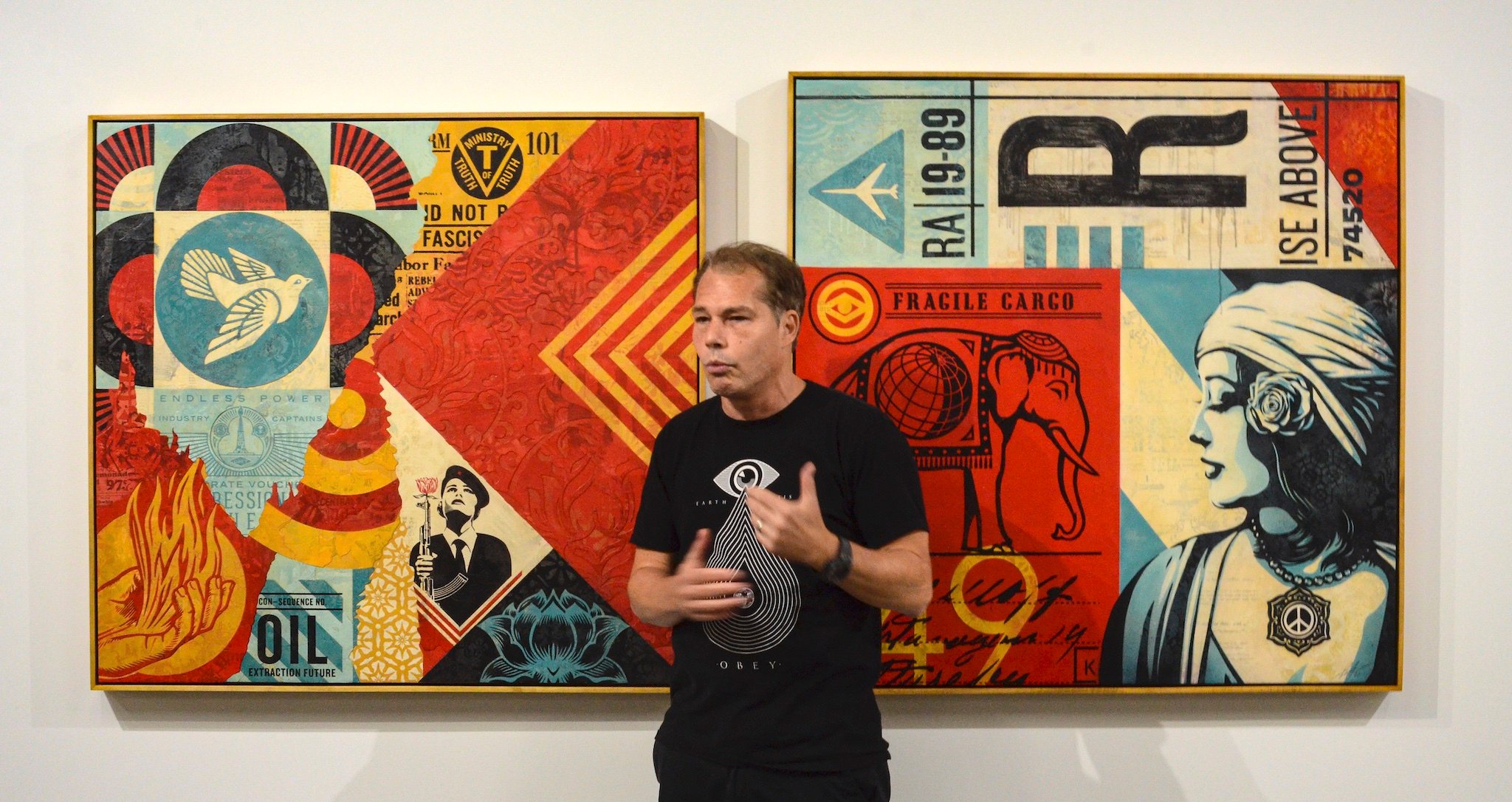
Celebrating Artistic ‘Symbols of Possibility’
Shepard Fairey's "Backward Forward" and Gabrielle Goliath's "Chorus" carry on an unlikely tradition of cutting edge art in Dallas.
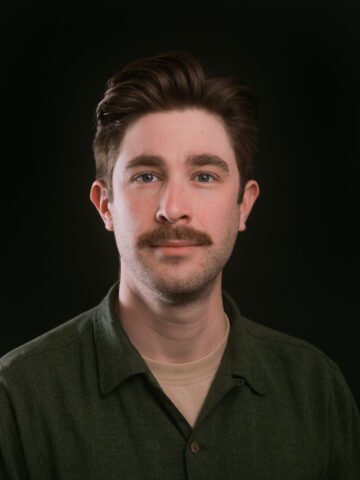
The mandatory and thankfully complimentary valet parking outside the Dallas Contemporary museum was a sign—typically, I’m not invited to things like this. But sure enough, my name was on the list for a VIP reception for the two most politically charged and timely art exhibitions I’ve ever seen.
The reception inaugurated the first showing of a new exhibition by world-renowned artist and activist Shepard Fairey, “Backward Forward.” It was also the first American showing of “Chorus,” an immersive performance art piece by South African multidisciplinary artist Gabrielle Goliath. Both exhibitions, boldly political in nature, have a particular resonance with the political climate in Texas.
Dallas is an unlikely host for cutting-edge political art. In 1955, the burgeoning art scene in the city was rocked by the “red art” controversy. The reactionary political climate in North Texas, documented vividly in books like Nut Country by Edward Miller and The Accommodation by Jim Schutze, engendered a fervid campaign by conservative citizen groups who sought to ban the exhibition of art they viewed as having communist affiliations. The Dallas Patriotic Council accused the Dallas Museum of Art of intentionally promoting “subversive” artists who were allegedly part of communist front groups connected back to the Soviet Union.
With the exception of avowed communists like Pablo Picasso and Diego Rivera, whose masterpieces were temporarily pulled from the walls of the Dallas Museum of Art, the accusations had no real basis. Within a year, cooler heads prevailed. In 1956, the museum declared they would not ban art.
An ironic result of the “red art” scare is that it inadvertently fostered the contemporary art scene in Dallas. Art patrons who wanted a space free from political pressure formed the short-lived Dallas Museum of Contemporary Art in 1956 (the museum merged with the Dallas Museum of Art in 1963). The still-operating Dallas Contemporary emerged about two decades later, initially showcasing exhibitions of work created by its members. Today, it occupies a 37,000-square-foot space and hosts exhibits by contemporary artists from around the world.
A lot has changed since the 1950s. Fairey’s “Backward Forward” received a warm welcome from Dallas’ art patron elite.
Looking at Shepard Fairey’s work, I saw the subjects of my own journalism staring back at me.
“It means a lot that this show is in Texas,” Fairey told me between swigs of Stella Artois. “Texas is not a monolith. There are a lot of people with different views, but what is dominating the politics here isn’t necessarily representative.”
As we talked, Fairey stood next to a painting featuring a hopeful-looking woman holding an AK-47 and a flower. Surrounding her, posters and paper rip away to reveal an advertisement promoting oil extraction and a news clipping about creeping fascism. The centerpiece of the exhibit, a 15-foot-tall sculpture of an AR-15 barrel crowned with a flower, looms over Fairey’s shoulder. It dominates the space and, in the wake of the Uvalde massacre, sends a clear message.
“I’m not anti-Second Amendment,” Fairey said. “But there should be more safeguards. Not unlike for drivers, who need a license to operate a car.”
Fairey has long made social and political statements through his art. “In the past, I was a bit more confrontational in my approach,” Fairey said. “Now, I try to figure out how I can make things that draw people in on their own terms.”
“Backward Forward” is an impressive and ambitious exhibition, even by Fairey’s large-scale standards. In addition to the centerpiece sculpture and two massive murals, dozens of paintings adorn nearly half of the museum space. Themes and techniques both old and new cohere into a unified visual narrative that addresses some of the pressing issues of our time. Refined paintings, illustrations and experimental sketches simultaneously incorporate and stray from the precise, political poster-print stylings for which Fairey is perhaps best known. Familiar imagery, such as portraits of civil rights icons, is juxtaposed with bold colors and textures to create a decoupage-like effect.
“I wanted the ripping effect to suggest an ongoing battle of narratives that requires a certain vigilance,” Fairey said. “Because democracy is fragile, and without vigilance, it can crumble.”
Looking at Fairey’s work, I saw the subjects of my own journalism staring back at me. Consider the breadth of topics touched on in one series of twenty paintings: police brutality and civil rights, climate change and the fossil fuel industry, false nostalgia and mindless consumerism, disinformation and social media, the great man theory of history, and more. Despite the heavy subject matter, a certain hopefulness shines through. Juxtaposition plays a key role. Guns are paired with flowers, doves carry olive branches, and the victories of past social movements are set against the challenges of today.
“I want to diagnose problems while also embedding symbols of possibility and improvement,” Fairey said. “When it comes to forces undermining democracy and spreading disinformation in the media, we have to think about both the problems and the solutions.”
Tucked away to the front of the museum is the entrance to Goliath’s exhibit, “Chorus.” You hear the exhibit before you see it: A hive-like hum emanates from a black curtain that gives way to a darkened room, where black floor pillows invite the viewer to be overwhelmed by sound and image. Projected onto two walls is a 23-minute video piece featuring the University of Cape Town Choir singing the same note. On a third wall is a list of every woman, child, trans, and gender non-conforming person killed in South Africa following the 2019 rape and murder of Uyinene Mrwetyana, a student at the University of Cape Town. Mywetyana’s death sparked a movement against gender-based violence, which caused the South African government to declare femicide a crisis. The list is dizzying to take in. There are 680 names.
The sustained performance of a single note serves as a beautifully haunting lament in Mrwetyana’s honor. Many of the performers were school friends of Mrwetyana and the grief of mourning plays out viscerally. As they sing, some members of the choir break into tears. Still, they keep singing. Watch long enough and you’ll end up crying too.
“People ask me, ‘Why show “Chorus” here?’” Goliath said, the hum still audible in the background. “And I say, ‘Why not?’”
In May of this year, Dee Dee Hall, a Black transgender woman, died while in police custody in Dallas after being arrested amid a mental health crisis. Several Black trans women have been murdered in the city over the last several years, receiving national attention. Goliath situates these incidents in the context of white, colonial, patriarchal power, and asks the viewer to consider the roots of misogyny, homophobia, and racism.
“These are the afterlives of colonialism, slavery, and apartheid.”
“These are the afterlives of colonialism, slavery, and apartheid,” Goliath said.
Events that occurred four hours south of Dallas just hours before the opening of “Chorus” further signified the pertinent timing. In Katy, a group of anti-LGTBQ+ extremists gathered alongside Proud Boys and neo-Nazis outside of a drag bingo fundraiser held by a church in support of the local trans community, part of an unsettling escalation of harassment against trans people in Texas.
Goliath hopes “Chorus” can create space for community and relational encounters where people can acknowledge the pain of others and engage in what she describes as the “transformative work of mourning.”
“Consider the close proximity to Uvalde, Roe v. Wade, and women’s rights, and the spate of murders of Black trans women,” Goliath said. “My work should be here.”
“Shepard Fairey: Backward Forward” will be on exhibition at Dallas Contemporary until July 23, 2023. “Chorus” by Gabrielle Goliath will be on exhibition until March 19, 2023. Entry is free to the public. Reserve a ticket at www.dallascontemporary.org.

